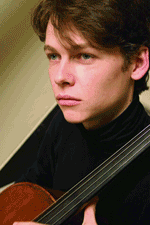> [Archived] Chronicles

The Amount of Music per Minute in Dukas, Shostakovich and Sibelius
The programme opened with Paul Dukas' L'apprenti sorcier, this symphonic poem being conducted by Valentin Reymond, who approached it in a clear, calm and elegant manner; he was impatient when it required a rushed, alert pace, fluidly moving between directions, from one part of the score to another.
Music that is performed truthfully, with conviction and passion, is beautiful, melodious, pleasant and captivating no matter its actual quality. That is not to say that Shostakovich's Cello Concerto No. 1 is not beautiful, melodious or captivating, but you would not want to listen to it daily at breakfast either, to ensure your good disposition. Mihai Marica, a 27-year old cellist with a career abroad, transformed it into the music without which a night would be incomplete. A great performer, a virtuoso, Mihai Marica played his own version of the piece, filtered by reason and sentiment, though almost always watching the conductor, and proved that he has a very particular tone colour. It is very pure, without additional sounds, but not appearing superficial because of this; it seems to be stripped down - if that is possible - to its very essence. Both Dmitri Shostakovich and Mihai Marica use the cello as a violin in this Concerto No. 1: they handle it with great ease, virtuosity, in a middle-to-high register, offering us a cello that is different from the grave and soft one we are used to.
Jean Sibelius' Symphony No. 1 was the ending piece. It created a wide space, like that of the opera music by Puccini or Richard Strauss - it is in fact extremely descriptive, imagining stories, actions, monologues and decors. This solar, effusive music was the setting for forty-five minutes of endless beauty.
Translated by Diana Maftei
MTTLC, Bucharest University














